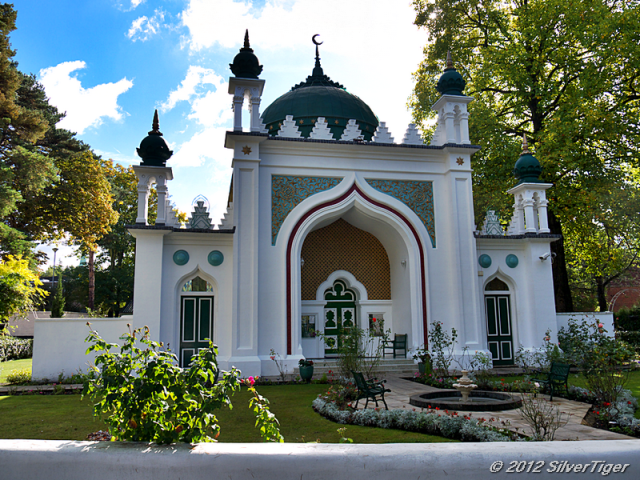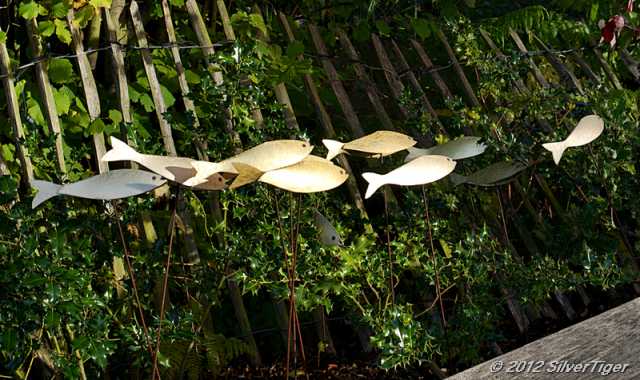Saturday, September 6th 2012
We are meeting friends today for an out of town trip. We have a good day for it with sunshine and a blue sky. It has started chilly but will probably warm up later. We took a bus to Waterloo station and had breakfast at Costa where we had arranged to meet our friends. When they joined us, we caught the 10:35 Weymouth train but our destination was the train’s very first stop, Woking.

Woking station
A long walk to the exit
From the station, we made our way to a long road called Oriental Road. This is an ordinary suburban road with tidy hedges,
dog-walking boots on the doormat,

Dog-walking boots on the doormat
A strange resonance with a later visit
building works that produce an impromptu garden pond,

Building works
An impromptu garden pond
and a scarred but lively old tree.

A scarred tree
Still full of life
From the other side,

A tree that looks like a hand…
…with long fingers
the tree looks like a hand with cupped palm and long fingers.

A first glimpse…
…of what we had come to see
We turned left down a lane and then caught a glimpse of what we had come to see, the Shah Jahan Mosque.

Shah Jahan Mosque
The first purpose-built mosque in Britain (1889)
We had come to Woking to see this historic building, the Shah Jahan Mosque. Built in 1889, it was Britain’s first purpose-built mosque, created, curiously enough, by someone who, though steeped in Muslim culture, was not a Muslim.
The community that runs the mosque today welcomes visitors and allows photography inside the building. The only restriction is that you are required to remove your shoes before entering, as is the normal practice in mosques.
The mosque was designed and built by orientalist Gottlieb Wilhem Leitner who was in fact Jewish. There is no evidence that he ever embraced Islam despite being educated in the religion and its culture. An interesting biography of Dr Leitner will be found here. That Web site, Shah Jahan Mosque, has a lot of information on the mosque and its functioning.


Small but beautifully restored
The mosque is listed, Grade II, and has been beautifully restored by the community that runs it. We felt the need to be discreet inside the mosque because there was another visitor, this one engaged in prayer, and we did not want to disturb or photograph him.

The mosque is set in a well tended garden
The mosque is set in a well tended garden which enhances its beauty.
The mosque is very small but forms the centre of the Muslim community. Around it, other buildings have been built to provide the needed space and to provide for various activities. Beside the mosque is this building which I was told was the school or madrassa.

Contrails above St Paul’s church
After visiting the mosque, we walked in leisurely fashion towards the centre of town, viewing anything that seemed interesting along the way. Quite near the mosque, its pointed spire contrasting with the latter’s minarets, is St Paul’s church. Above it, among the clouds, passing aircraft left contrails, chalked in white against the blue.


Clock tower
Blue to match the sky
In Maybury Road, which takes its name from the relatively modern name of the area of Maybury, we were attracted by a building with a clock tower. It is obviously a building with a history but I so far remain in ignorance of what this was. It is now an apartment block.

Planet Cafe
A talent for getting the orders wrong
When we came upon this cafe, we decided it was time for lunch. Unfortunately, it is a Polish cafe and the waitress seemed to have difficulty with the English language. She managed to get most of the orders wrong – coffee instead of tea, beans instead of peas, the wrong omelette – so we had quite a game getting the food we wanted. For some reason, Tigger’s order got put back in the queue and she had to wait until the rest of us had finished eating before hers arrived. In the meantime, a plate of peas turned up on the table for no obvious reason…


Martian vehicle
After H.G. Wells, War of the Worlds
There are many references to journalist and science fiction author H.G. Wells in Woking, including a pub of that name, though I think the writer lived there only for a relatively short time. This sculpture represents one of the three-legged vehicles used by the Martian invaders as recounted in Wells’s novel, War of the Worlds.

The Lightbox
Woking’s Art Gallery and Museum
We were heading towards this place, The Lightbox. Opened in 2007, it’s Woking’s art gallery and museum. I don’t think the name, which suggests photography rather than art and history, is particularly suitable. According to the Web page, “The Lightbox has some of the most exciting gallery spaces in the South East”, which rather overstates the case when you think of some of the other, far superior, galleries in the South East. On display are art works by known and lesser known artists. There is also a programme of visiting exhibitions, the current one being Suki Chan’s installation called Still Point, which was about as thrilling as watching paint dry. The four of us managed to hold out for about 10 minutes and I wouldn’t be surprised to learn that this is a record.

General view
Photography otherwise not allowed
Admission to the gallery is free and it has a pleasant cafe. Photography is not allowed (there are the familiar crossed-out camera icons everywhere) but we were allowed to take a general shot, as above. I have grumbled often enough about public galleries than ban photography so I will not rehearse my objections again here. Despite my criticisms, the Lightbox is certainly worth visiting and I would go again if we were to return to Woking.

Christ Church, Woking
Like the Mosque, built in 1889
We turned again towards the centre and made our way slowly towards the station. We passed through the Town Square in which the Victorian pile of Christ Church stands. There was time for another couple of pictures before we caught a train back to Waterloo.

Selling off cheap
End-of-the-day bargains
We passed through the market which seemed quite busy. The stallholders on this fruit and vegetable were selling off their wares cheap at the end of the day and had gathered an interested crowd.
You can tell them not to do it; you can put up notices; you can impose fines; but people still feed the pigeons. This woman’s guilty expression probably comes from thinking I might be a council snoop. I like pigeons and understand why people feed them, but I still think they should not do so. It encourages pigeons to congregate and cause a nuisance which, ultimately, is bad for the pigeons, as they are the ones who suffer when pest control measures are taken.

Waterloo station
View from the upper level
Back at Waterloo station, we went onto the newly opened upper level and had cake and coffee at Carluccio’s. Waterloo is just one station to capitalize on its grandiose proportions to make extra money by creating a commercial level with shops and restaurants. The Waterloo upper level is not to obtrusive and offers fine views of the concourse. With a little imagination, you can have an idea of what it is like to be one of the pigeons flying about among the roof supports!

Station clock
People still meet under the clock at Waterloo
The station clock is a time-honoured place for people to meet and, over the years, thousands must have used this one as a trysting place. It is unusual to get such a close view, however, and this one is possible only because the upper level brings you near to it.
Was Woking worth a visit? I would say that it was, even if the Lightbox was a little disappointing and the town itself, despite its history, seemed rather nondescript. Perhaps in our brief visit, though, we missed the best bits. The jewel in the crown, so to speak, is the Shah Jahan Mosque and it is good to see that the community is taking good care of it as well as keeping it in use.

Shoal of fish
The Lightbox, Woking
Copyright © 2012 SilverTiger, https://tigergrowl.wordpress.com, All rights reserved.








Lovely! The mosque has been on my ‘to visit’ list for ages, so I really enjoyed this look inside.
LikeLike
Yes, it’s well worth a visit and nice that the community encourages this.
LikeLike
I liked the exterior of the Light Box gallery. Interesting “scale” effect and coloring. There is something proportionally pleasant about Islamic architecture.
LikeLike
As modern buildings go, the Lightbox isn’t too bad. The boxy shape allows maximum space inside though the interior is in fact divided into a lot of fairly small spaces, which include lecture rooms and activity rooms. You get the feeling that some of the displays have been pushed out into the corridors, though that’s probably not the intention.
I’m not quite sure how the Shah Jahan Mosque was designed but I imagine it was intended to be as “Islamic” as possible within its small frame. In a sense, it is a pattern book of mosque design.
Watching a documentary the other evening, we saw a carpet with an identical pattern to the one in Shah Jahan in a mosque in the North of England.
LikeLike